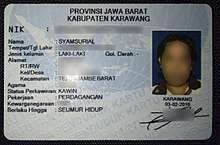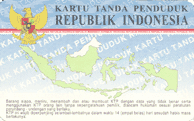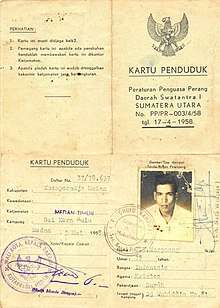Indonesian identity card
The Kartu Tanda Penduduk (literally: Resident Identity Card), commonly KTP, is an Indonesian compulsory identity card. Separate versions exist for Indonesian and non-Indonesian residents.[1] The card is issued upon reaching the age of 17 or upon marriage.[1] In the case of Indonesian citizens, the card is valid for lifetime (previously it only valid for 5 years for citizens under 60 years old). For non-Indonesian citizens, the card's expiry date is the same as that of their residency permit.[1] Since 2011, the Indonesian governments has issued an electronic ID card, the e-KTP (KTP elektronik), which contains a modern embedded microchip.




History
Dutch East Indies
The general identity card during the Dutch colonial era was called a residence certificate (Dutch: verklaring van ingezetenschap). This card did not record the bearer's religion.[2] Citizens seeking to obtain proof of residence were required to contact their local controleur (controller) and pay a fee of 1.5 guilders. The paper card measuring 15x10 cm was issued and signed by heads of local administrations (hoofd van plaatselijk).[3] Two additional types of ID documents were required by Chinese in the Dutch East Indies: the entry permit (Dutch: toelatingskaart) and the residency permit (vergunning tot vestiging, known as ongji by Chinese).[4]
Japanese period
The Japanese occupation (1942–45) ID card was made from paper and was much wider than the current KTP. It featured Japanese and Indonesian text. Behind the main data section was a propaganda spiel that indirectly required the holder to swear allegiance to the Japanese invaders. Hence it became known as KTP-Propaganda.[5]
First 32 years of independence

After Indonesia declared independence in 1945, the certificate of residence was replaced with the Indonesian Citizenship Certificate (Surat Tanda Kewarganegaraan Indonesia). This document was partly typed and partly handwritten. It was in use from 1945 to 1977.[3] It was a paper card without any laminate. The card underwent several changes during this period, partly concerning the rights and responsibilities of the bearer. Different ID cards were issued by different regions and eventually became uniform under the head of Population Registration in 1976.
Discrimination
During Suharto’s New Order regime (1966–98), citizenship cards held by former political prisoners (tahanan politik or tapol) and ethnic Chinese featured special codes to denote their status.[6][7] This policy allowed government officials to know whether a person was a former political prisoner or of Chinese descent. The discriminatory codes were later abandoned.
1977-2003 KTP
The KTP was made from paper, laminated in plastic and stamped with an ink stamp. Cards were issued by the lowest neighborhood administrative levels, known as RT and RW. The cards featured a photo, signature, serial number and thumb print. The background color of the KTP was often yellow.[3]
Aceh Emergency KTP
When Aceh province was placed under a state of Military Emergency in 2003, it had a different KTP design featuring a red and white background and a garuda bird. The card was signed by the subdistrict head, the local military commander and head of police.[3]
2004-2011 KTP
The bearer’s photo was printed directly onto a plastic card. Surveillance, verification and validation remained at the RT/RW levels. This KTP featured the bearer’s thumb print and a unique serial number.[3]
Electronic KTP (e-KTP)
The e-KTP was trialed in six areas in 2009 and launched nationwide in 2011. The card is supposed to be more durable, contains a microchip, unique serial number and can be used for multiple applications for government services.In May 2013, it was reported the chip inside the e-KTP could be damaged and rendered useless by repeatedly photocopying the card.[8]
The e-KTP contains unique biometric data and was designed to improve government services and population databases, while reducing fraud and security threats.[9][10]
The e-KTP is the basis for the issuance of Indonesian passports, driving licenses (SIM), Taxpayer Identification Numbers (NPWP), insurance policies, land ownership certificates and other identity documents (Article 13 of Law no. 23 year 2006 on Adminduk).
Data recording for e-KTP registration involves taking fingerprints from all 10 fingers, although the card's chip records only the right thumb and index finger prints. The e-KTP consists of nine layers to increase security. A chip is implanted between white and transparent plastic on the top two layers. The chip has an antenna that issues a wave when swiped. The wave will be recognized by a detector to verify whether the rightful holder is using the card. Data storage in the chip is in accordance with international standards and NISTIR 7123 Machine Readable Travel Documents ICAO and EU Passport 9303 Specification 2006. The size of the card is in accordance with ISO/IEC 7810 with a credit card size form factor that is 53.98 mm x 85.60 mm.
Indonesia's e-KTP program achieved 100 million biometric enrollments and de-duplications in just under one year.[11] e-KTP data has no expiration date, even if the cards show expiration dates.[12]
Religion
The card requires identification with one of the six officially recognised religions in Indonesia: Islam, Protestantism, Catholicism, Hinduism, Buddhism and Confucianism. In 2006 the need to retain this arrangement was reiterated by Minister of Religious Affairs Maftuh Basyuni: "official religions of the country is vital to ensuring good harmony between religious groups as well as being of use in more practical matters such as marriage and burial."[13] But in 2014, the Minister of Home Affairs suggested that the section should be optional, that is, that it could be left blank. Religious groups want to retain it.[14] Following the ruling of Constitutional Court of Indonesia, As per 1 July 2018, believers of indigenous faith are allowed to put "penghayat kepercayaan" or (believer) on religion column in identification card.[15][16]
Confucianism as an option was reinstated in 2006, having been dropped in 1965 by Suharto in the wake of the failed communist coup attempt.[17]
Information on the card
- Single Identity Number (Indonesian: Nomor Induk Kependudukan (N.I.K.))
- full name
- place and date of birth
- gender
- marital status
- religion
- blood type
- address
- occupation
- nationality
- photo
- expiry date (still has this column even though the card is valid for a lifetime, since previously it was only valid for 5 years[18])
- place and date of issue
- bearer's signature
- issuing officer's name & signature
- validation under the photo
e-KTP History
The Home Affairs Ministry in 2009 commenced a trial implementation of e-KTP in six regions: Makassar, Padang, Denpasar, Yogyakarta, Cirebon and Jembrana.[19]
References
- "Indonesian Law 23 of 2006" (in Indonesian). Retrieved 2010-10-01.
- Kurniawan, Hasan (14 November 2014). "Asal Usul Kolom Agama di KTP". SINDOnews.com. Retrieved 11 September 2017.
- Adnan, Sobih AW (12 February 2016). "Sejarah Panjang KTP Indonesia". Metrotvnews.com. Retrieved 11 September 2017.
- Kwartanada, Didi (2016). The Papers that Surveiled - Identity Cards and Suspicion of the Chinese (PDF). Gazing on Identity. Yogyakarta.
- Kahu, Joshua Riwu (26 August 2015). "10 Evolusi bentuk KTP Indonesia, kamu pernah punya yang mana?". Brilio.net. Retrieved 11 September 2017.
- Ariel Heryanto (7 April 2006). State Terrorism and Political Identity in Indonesia: Fatally Belonging. Routledge. pp. 17–. ISBN 978-1-134-19569-5.
- Napier, Catherine (1 June 1999). "The Chinese dilemma". BBC News. Retrieved 11 September 2017.
- "Photocopiers Destroy New Indonesian Identity Card Chips". The Jakarta Globe. 6 May 2013. Retrieved 11 September 2017.
- "Indonesian cards". Professional Security Magazine. Retrieved 8 September 2017.
- Messmer, Ellen (20 September 2012). "Indonesia advances world's most ambitious biometric-based national identity card project". Network World. Retrieved 8 September 2017.
- http://www.planetbiometrics.com/article-details/i/1261/
- Ihsanuddin (30 January 2016). Assifa, Farid (ed.). "E-KTP Berlaku Seumur Hidup meski Ada Tanggal Kedaluwarsanya". Kompas.com. Retrieved 24 October 2016.
- KTP Religion, indonesiamatters.com, May 8th, 2006
- Minister of Home Affairs suggests the religion section in Indonesian ID cards (KTP) should be optional, Muslim clerics disagree, Coconuts Jakarta, 7 Nov 2014
- Constitutional Court rules indigenous faiths 'acknowledged' by state, Jakarta Post, 7 Nov 2017
- Mulai 1 Juli 2018, kolom agama di KTP bisa diisi aliran kepercayaan, Merdeka, 7 Nov 2017
- Confucianism Religion or Khonghucu, indonesiamatters.com, May 8th, 2006
- https://en.tempo.co/read/740095/jakarta-id-card-is-valid-for-a-lifetime-official Jakarta ID Card is Valid for a Lifetime: Official
- "KTP Jenis Baru Akan Diterapkan di Enam Kota". Viva Media Baru. 16 November 2009. Retrieved 8 September 2017.